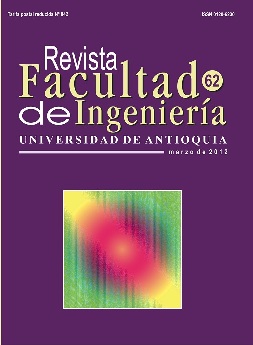Calibration and validation a 3D in the Santa Marta coastal area (Colombia)
DOI:
https://doi.org/10.17533/udea.redin.12478Keywords:
numerical modeling, calibration, validation, hydrodynamic, 3D modelAbstract
This paper presents the calibration and validation of a hydrodynamic model to simulate the tides, currents and salinity and temperature conditions in the coastal area of Santa Marta Bay. The methodology used includes the numeric implementation of the model, the development of field measurements, and measurements data compared with simulations data. The error between measurements and simulations data was estimated to determine the quantitative reliability of the model.
Downloads
References
A. Gordon. “Circulation of the Caribbean Sea”. J. Geophys. Res. Vol. 72. 1967. pp. 6207-6223. DOI: https://doi.org/10.1029/JZ072i024p06207
S. Murphy, H. Hurlburt, J. O’Brien. “The connectivity of eddy variability in the Caribbean Sea, the Gulf of Mexico, and the Atlantic Ocean”. J. Geophys. Res. Vol. 104. 1999. pp. 1431-1453. DOI: https://doi.org/10.1029/1998JC900010
C. Andrade, E. Barton. “Eddy development and motion in the Caribbean Sea”. J. Geophys. Res. Vol. 105. 2000. pp. 26191-26201. DOI: https://doi.org/10.1029/2000JC000300
W. Johns, T. Lee, F. Schott, R. Zantopp, R. Evans. “The North Brazil Current retroflection: Seasonal structure and eddy variability” J. Geophys. Res. Vol. 95. 1990. pp. 22103-22119. DOI: https://doi.org/10.1029/JC095iC12p22103
D. Arévalo, A. Franco. “Características oceanográficas de la surgencia frente a la ensenada de Gaira, departamento de Magdalena, época seca menor de 2006”. Bol. Invest. Mar. Cost. Vol. 37. 2008. pp. 131- 162.
J. Vega, A. Rodríguez, M. Reyes, R. Navas. “Formaciones coralinas del área de Santa Marta: Estado y patrones de distribución espacial de la comunidad bentónica”. Bol. Invest. Mar. Cost. Vol. 37. 2008. pp.87-105.
J. Garzón, J. Díaz. The Caribbean coral reefs of Colombia. Latin American Coral Reefs. Ed. Elsevier Science. Amsterdam. 2003. pp. 301.
M. Fossati, I. Piedra. “Numerical modelling of residual flow and salinity in the Rio de la Plata”. Appl. Math. Model. Vol. 32. 2008. pp. 1066-1086. DOI: https://doi.org/10.1016/j.apm.2007.02.034
C. Palacio, F. García, U. García. “Calibración de un modelo hidrodinámico 2D para la bahía de Cartagena”. Dyna. N°. 164. 2010. pp. 152-166.
B. Miller, W. Peirson, Y. Wang, R. Cox. “An overview of numerical modelling of the Sydney deepwater outfall plumes”. Mar. Pollut. Bull. Vol. 33. 1996. pp. 147-159. DOI: https://doi.org/10.1016/S0025-326X(97)00077-5
C. Cook, G. Orlob, D. Huston. “Simulation of winddriven circulation in the Salton Sea: Implications for indigenous ecosystems”. Hydrobiologia. Vol. 473. 2002. pp. 59–75. DOI: https://doi.org/10.1007/978-94-017-3459-2_5
A. Teeter, B. Johnson, C. Berger, G. Stelling, N. Scheffner, M. Garcia, T. Parchure. “Hydrodynamic and sediment transport modeling with emphasis on shallow-water, vegetated areas (lakes, reservoirs, estuaries and lagoons)”. Hydrobiologia. Vol. 444. 2001. pp. 1-23. DOI: https://doi.org/10.1023/A:1017524430610
J. Dias, J. Lopes. “Implementation and assessment of hydrodynamic, salt and heat transport models: The case of Ria de Aveiro Lagoon (Portugal)”. Environ. Modell. Softw. Vol. 21. 2006. pp.1-15. DOI: https://doi.org/10.1016/j.envsoft.2004.09.002
F. García, C. Palacio, U. García. “Generación de mallas no estructuradas para la implementación de modelos numéricos”. Dyna. N. 157. 2009. pp. 17-25.
M. Li, L. Zhong, W. Boicourt. “Simulations of Chesapeake Bay estuary: Sensitivity to turbulence mixing parameterizations and comparison with observations”. J. Geophys. Res. Vol. 110. 2005. pp. 27-36. DOI: https://doi.org/10.1029/2004JC002585
J. Dias, M. Sousa, X. Bertin, A. Fortunato, A. Ooliveira. “Numerical modeling of the impact of the Ancão Inlet relocation (Ria Formosa, Portugal)”. Environ. Modell. Softw. Vol. 24. 2009. pp. 711-725. DOI: https://doi.org/10.1016/j.envsoft.2008.10.017
F. Garcia, C. Palacio, U. García. “Uso de un modelo regional para el mar Caribe para obtener condiciones fronteras abiertas en un modelo local para la bahía de Santa Marta – Colombia”. Bol. Cient. CIOH. Vol. 26. 2008. pp. 33-46. DOI: https://doi.org/10.26640/22159045.175
A. Mehra, I. Rivin. “A real time ocean forecast system for the North Atlantic Ocean”. Terr. Atmos. Ocean. Sci. Vol. 21. 2010. pp. 211-228. DOI: https://doi.org/10.3319/TAO.2009.04.16.01(IWNOP)
R. Pawlowicz, B. Beardsley, S. Lentz. “Classical tidal harmonic analysis including error in MATLAB using T-TIDE”. Comput. Geosci. Vol. 28. 2002. pp. 929-937. DOI: https://doi.org/10.1016/S0098-3004(02)00013-4
F. Garcia, C. Palacio, U. García. “Constituyentes de marea en la bahía de Santa Marta”. Dyna. N°. 167. 2011. pp. 142-150.
I. Martins, J. Dias, E. Fernandes, J. Muelbert. “Numerical modelling of fish eggs dispersion at the Patos Lagoon estuary – Brazil”. J. Marine Syst. Vol. 68. 2007. pp. 537-555. DOI: https://doi.org/10.1016/j.jmarsys.2007.02.004
A. Oliveira, A. Fortunato, L. Pinto. “Modelling the hydrodynamics and the fate of passive organisms in the Guadiana estuary”. Estuar. Coast. Shelf Sci.. Vol. 70. 2006. pp. 76-84. DOI: https://doi.org/10.1016/j.ecss.2006.05.033
Downloads
Published
How to Cite
Issue
Section
License
Copyright (c) 2018 Revista Facultad de Ingeniería

This work is licensed under a Creative Commons Attribution-NonCommercial-ShareAlike 4.0 International License.
Revista Facultad de Ingeniería, Universidad de Antioquia is licensed under the Creative Commons Attribution BY-NC-SA 4.0 license. https://creativecommons.org/licenses/by-nc-sa/4.0/deed.en
You are free to:
Share — copy and redistribute the material in any medium or format
Adapt — remix, transform, and build upon the material
Under the following terms:
Attribution — You must give appropriate credit, provide a link to the license, and indicate if changes were made. You may do so in any reasonable manner, but not in any way that suggests the licensor endorses you or your use.
NonCommercial — You may not use the material for commercial purposes.
ShareAlike — If you remix, transform, or build upon the material, you must distribute your contributions under the same license as the original.
The material published in the journal can be distributed, copied and exhibited by third parties if the respective credits are given to the journal. No commercial benefit can be obtained and derivative works must be under the same license terms as the original work.










 Twitter
Twitter